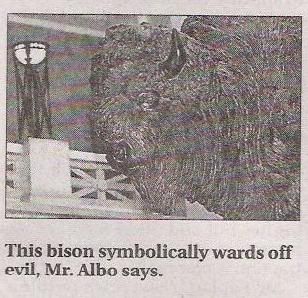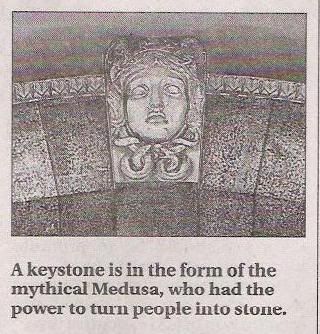The architecture of Nicholas Hawksmoor has been the subject of considerable interest in the last half-century, where his work had previously been almost completely ignored. His major churches: St Alphege, Greenwich; St Anne, Limehouse; St George-in-the-East; Christ Church, Spitalfields; St George, Bloomsbury; St Mary Woolnoth: these have become important loci of London occult and psychogeographical thought - originally brought to the attention of the reading public by Iain Sinclair in Lud Heat, the book which provided the impetus and the inspiration for Peter Ackroyd's Hawksmoor.
Both Ackroyd and Sinclair see Hawksmoor's churches as centres of malevolent energies which are connected with the Ratcliffe Highway and Whitechapel murders; Sinclair places the churches at the angles of a sign of Set, and sees them as cult centres, temples for malignancies which have yet to be laid to rest:
From what is known of Hawksmoor it is possible to imagine that he did work a code into the buildings, knowingly or unknowingly, templates of meaning, bands of continuing ritual. The building should be a Temple, an active place, a high metaphor.
It is an attractive theory, but falls down a little when we consider that it's only natural for churches to feel like temples and places of ritual; and that many churches are built on old religious sites, close to graveyards; and that one might draw straight lines between Wren churches and come up with a similar symbol (though I confess I have not tried). Yet it cannot be denied that the Hawksmoor churches make a profound impression. The most interesting aspect of the idea, it seems to me, is why they should prompt thoughts of gloom and mystery: why is it so easy to associate them with murder and the occult? Why do they have this effect on the imagination?
Hawksmoor himself is largely unknowable; he left few letters, and all we know of his character is what can be drawn from his career: he was a genuine professional in an age of gentlemen amateurs, very highly regarded by his contemporaries, who was disappointed of the high offices which he expected and which he deserved. By the end of his life, his architectural style had fallen out of favour and was derided by neo-Palladians. Perhaps this may explain the melancholy of his later letters, and some of his interest in gloomy funereal monuments - shown to its best advantage in his mausoleum at Castle Howard.
On the other hand, Hawksmoor's tutelage under Wren seems to have instilled in him a deep love and respect for the monumental architecture of antiquity, even though he never left Britain and only knew such buildings through engravings. He scoured architectural treatises for sources: the description of the tomb of Mausolus in Pliny (which is the source for the steeple of St George, Bloomsbury); the ancient tombs at Baalbek, which provided the inspiration for Hawksmoor's use of the giant order and huge, raised hexastyle porticoes in several churches; the tomb of Cecilia Metella on the Appian Way... His respect for antiquity was extended (most unusually, for the time) to the Gothic, which he aped with some success at All Souls College and the towers of Westminster Abbey.
It is, however, the massive character of Hawksmoor's work which is most Gothic in mood; and here we can see Hawksmoor in context, as one of the two great architects of the English Baroque. He worked with the other, Sir John Vanbrugh, at Castle Howard and Blenheim Palace where the huge mediaeval masses of the houses are tempered with the classical orders, rather than articulated by them. After these buildings, the two architects worked separately (though they were colleagues at the Office of Works) and their styles also diverged. Vanbrugh followed his inclination for grandiose, eccentric statements of mass and stark statements of what he termed 'the Castle air'; Hawksmoor's style became more antiquarian in feel, though it is equally individual.
Hawksmoor was the author of many extraordinary designs for colleges and for urban planning, which featured immense oval chapels, public fora, colonnades, sweeping wings, and everywhere the giant columnar orders and strange architectural elements isolated on pedestals. But in this as in his employment, he was denied fulfilment; his plans were too grandiloquent for conservative tastes to contemplate, and far, far too expensive. It is in these designs that we can see his true nature as a baroque architect: his use of masses and forms to create unity in his buildings' elevations, the theatricality of the central focus, the grand compositional effects; the concentration on the intrinsic qualities of architecture, rather than the extrinsic, decorative elements.
Yet Hawksmoor's buildings lack the plasticity of the continental Baroque; he ignores the play of motifs and elements just as he ignores Wren's rather stately, ordered style, and he lacked Vanbrugh's feeling for monumental form. His feeling for classicism, for massive masonry walls, for stone itself, was manifested in buildings composed of apparently stark yet deeply considered facades, buildings which seem heavy and sometimes lowering in feeling. The culmination of the style is undoubtedly his churches, built to meet Vanbrugh's criteria, which were that churches should have 'the most Solemn and Awfull Appearance without and within.'
So, to return to my original question, why are these churches so striking? They are, on the face of it, churches which conform to a standard pattern (much like the Wren churches, in fact), mediaeval forms dressed in a plain classicism. Yet the more one looks at them, the more bizarre they appear. Some have seen Hawksmoor's obsession with monuments and monumentality as morbid, and it's easy to see how the characteristic flattened arches of the interiors and the massive character of the recessed walls contribute to the impression of weight, and gloom. The ambiguity of the spaces creates a slight feeling of unease.
But the chief expression of the architect's originality can be seen in the exteriors. The huge variations on the Venetian window at Christ Church, Spitalfields; the pepperpot towers at St George-in-the-East; the enormous portico at St George, Bloomsbury, a very compressed church; the strong rustication of the tiny St Mary Woolnoth; the temple front and Roman urns (on Hawksmoor's beloved pedestals) at St Alphege; and St Anne's peculiar, apsidal west front. Finally, one comes to the towers and the steeples, splitting the sky, where Hawksmoor's invention ran riot. The massive, recessed belfry stages weigh down upon the long body on the church, and are surmounted by perverse steeples which seem to lean away from the passerby, by strange pyramid-like structures, by classicised octagonal lanterns (both enclosed and open to the air), and by antiquarian attics. Everywhere one finds isolated elements - pyramids, urns, altars - used as pinnacles. The oppressed churches sprout Hawksmoor's inventions, reaching white into the sky, looking like bleached bones.



